Qualcomm’s New 3rd Generation Snapdragon X60 5G Modem, Built on 5nm
by Dr. Ian Cutress on February 18, 2020 7:30 AM EST- Posted in
- Smartphones
- Qualcomm
- 5G
- mmWave
- Modem
- Sub 6 GHz
- Snapdragon X60
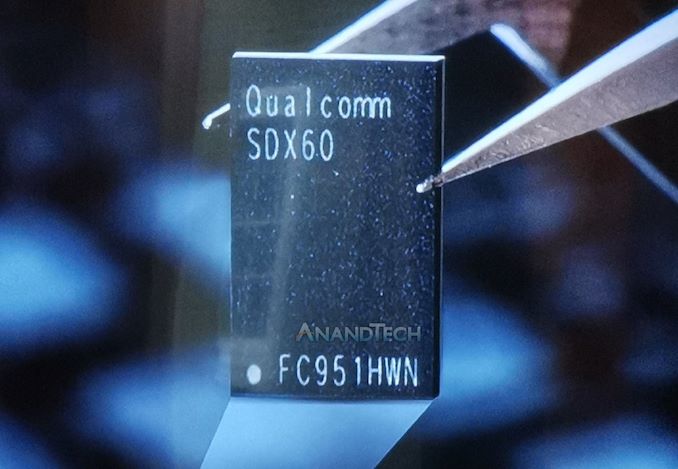
To date Qualcomm has promoted two key standalone 5G modems for widespread adoption: the Snapdragon X50 and the Snapdragon X55. Today the company is disclosing details on its upcoming 3rd generation 5G modem design, the Snapdragon X60, which is being promoted as the premium offering for smartphones, industrial, and commercial designs that require a discrete 5G modem. Key features of this modem include the fact that it is built on a 5nm process, supports carrier aggregation between Sub-6 and mmWave, and offers up to 7.5 Gbps download speeds.
The fact that Qualcomm is outright saying that their modem is going to be built on 5nm at this point of the game is very interesting, especially given TSMC’s recent disclosures on the capability of its 5nm process and its current timeline of development.
With the Snapdragon X60, Qualcomm is promoting support for more features of 5G, such as carrier aggregation between Sub-6 GHz bands in FDD/TDD (similar to LTE carrier aggregation), and support for simultaneous carrier aggregation between Sub-6 GHz and mmWave 5G bands. This leads to big jumps in peak bandwidth support, with Qualcomm listing up to 7.5 Gbps download over mmWave, 3 Gbps upload, and up to 5 Gbps download over Sub-6 GHz.
These peak speeds with the X60 modem is going to be achieved through new mmWave antenna modules. For the X50/X55, Qualcomm introduced its QTM525 module for mmWave, in a slim packaging to help enable the technology. Despite the sleek stature, the X50/X55 modems supported four of these modules, and Qualcomm recommended a minimum of three – the replacement of which did require these devices to be of a specific minimum thickness to ensure complete coverage. The new QTM535 module is promoted to be thinner, reducing that requirement.
Unfortunately the diagram showed by Qualcomm of the new module (as they didn’t have a physical one to show us) was not to scale, so no real conclusions could be drawn to the old module. Qualcomm also stated that they were not discussing dimensions at this time, despite the fact that the QTM525 launch was all about the dimensions. The new module can support 26 GHz, 28 GHz, and 39 GHz, enabling wider support. Qualcomm is going to keep its recommendation to vendors to use at least 3 in a connected device.
Alongside the modem and the mmWave antenna, Qualcomm is also offering the full RF front end for Sub-6 GHz. Qualcomm was proud to promote last year at its Tech Summit that out of the 150 devices that were using X50/X55 modems, all of them were using Qualcomm’s RF front-end solution. The X60 will similarly be a full stack offering.
Rollout of Qualcomm’s 5G modems has been a varied affair, with the time between the initial announcement of the first generation X50 and it actually launching into consumer devices being around two years. The process was sped up with X55, with a quicker time to market and eventually widespread deployment for consumer devices through the end of 2019 and likely for all of 2020. There was no doubt that Qualcomm was going announce its next generation design at some point, and with X55 in full swing, that time would appear to be now. When asked regarding timeframe of the X60, Qualcomm stated that they’re not sticking to any timeframe, with a spokesperson saying ‘these things go through revisions’. It is worth noting that for 5nm, TSMC has not yet entered high-volume manufacturing on this node yet (it will do soon, but yields are still low according to the ISSCC 2019 disclosure in December), and Samsung is further behind. So the exact timeframe for X60 rollout maybe sometime in 2021 at our best guess. Qualcomm has an annual Tech Summit in December, so we might see some of the first X60 reference designs at that event, likely with early silicon or the first batches of production silicon.
With MWC now cancelled, we might expect to see updates to the Snapdragon X60 news later in the year, perhaps at IFA in late August, or at Qualcomm’s own 5G analyst event. Then there’s always the Tech Summit in December.


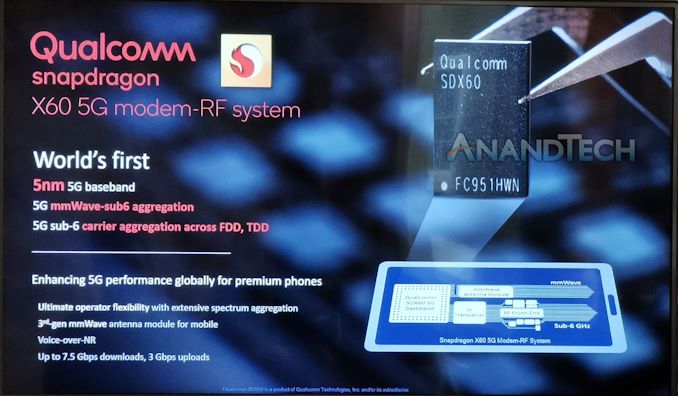
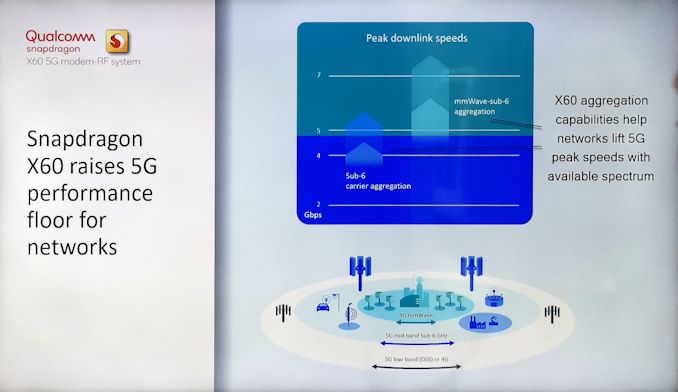
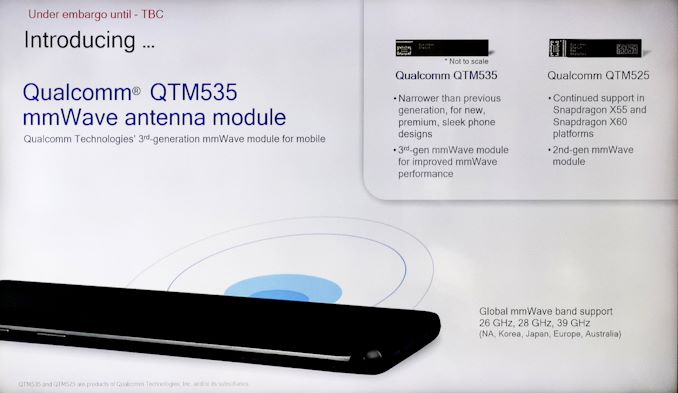
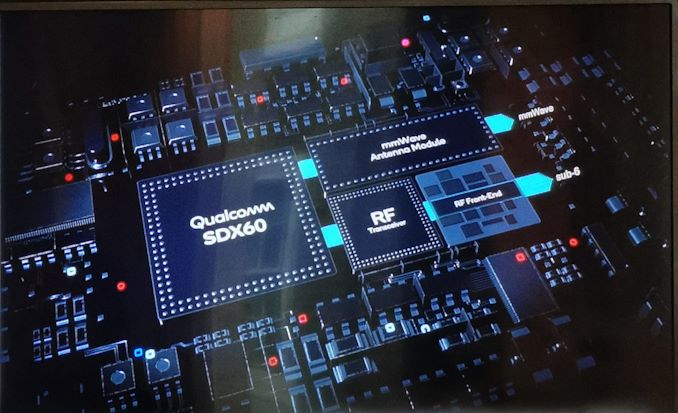
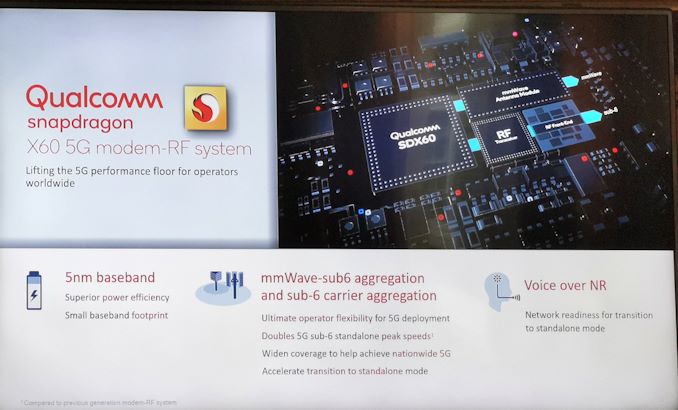








50 Comments
View All Comments
levizx - Wednesday, February 19, 2020 - link
Your argument is flawed from the beginning. Firstly, MTK's modem is actually LESS efficient than Qualcomm's and taking up more space on comparable speed. If MTK can do it with N7, Qualcomm will have zero problem integrating X55/60 with N5/5LPE.And secondly, 5G modem's heat "issue" is a non-issue, you almost NEVER require CPU and GPU and BP to work at full speed at the same time, I couldn't think of one scenario. AND 5G infrastructure won't actually support 7.5Gbps anyway, so integrating a 2.3Gbps or 7.5Gbps modem makes practically zero difference. In fact, since bigger modems require more DSPs, running those at lower speed actually save you some power vs fewer DSPs@higher speed for the same bandwidth.
As for cheaper, it is a fact. Qualcomm HAVE TO make the discreet modem. With the increased cost of chip design @ 7nm and below, it is simply cheaper to use modules. Sure overall the silicon is bigger, but yield goes much higher as well. I believe Qualcomm might start using 2.5/3D packaging instead for a couple of years.
s.yu - Friday, February 21, 2020 - link
X55/60 support mmWave, D1000 doesn't, and I stressed that while it's largely wasted space, it's due to the state of mmWave infrastructure, you still can't do the math cutting it out of Qualcomm's modems.Regarding the heat, 5G is less efficient on almost any load compared to 4G, I'm just not sure how much of an impact that makes.
As for the rest, you're really not disagreeing with me.
PandaBear - Wednesday, February 26, 2020 - link
It is not just 5G vs LTE, the amount of bandwidth means the amount of hardware to do the DSP, so your 80MHz aggregation going 320MHz would be 4x as many hardware to support it, then the battery life, and the heat, and the physical dimension to handle such battery size. Nobody will do it unless there's a demand, and nobody would buy it unless the deployment is there.melgross - Friday, March 6, 2020 - link
They’re also going to continue to need a standalone version for Apple, as they won’t allow them to integrate it into Apple’s chips. Apple has always used standalone modems, so this won’t be any different. In addition, if they want to continue to have Apple as a customer, as they do, they will have to offer them something so that their (Apple’s) modem project won’t come to fruition too soon.jackiebond - Tuesday, March 10, 2020 - link
Very nice interesting...https://bit.ly/2VW2Qe91_rick - Tuesday, February 18, 2020 - link
I'm pretty sure QC said there won't be a 4G-only SD865. (Well, it doesn't have a modem at all--you have to use the X60 chip, and that only comes with 4G+5G).reggjoo@gmail.com - Tuesday, February 18, 2020 - link
You forgot about the 765g soc. It has the 5g modem integrated already. They’ve already have a example , that they can do that. The 865 doesn’t have that, but the next revisions will.levizx - Wednesday, February 19, 2020 - link
They can, but probably won't. Maybe they'll use 2.5D-packaging next time but before Apple ditches Qualcomm altogether some time beyond 2023, they will probably keep doing the AP+BP dual chip setup.PandaBear - Wednesday, February 26, 2020 - link
They always started out separate until the 2nd generation. Getting the whole single chip wrong can be a big mess whereas just the modem wrong is ok.PeachNCream - Tuesday, February 18, 2020 - link
Meh, whatever. I'll get excited about 5G when US-based TELCOs stop gimping us with monthly data allotments or charging excessively for an unlimited plan. And I suppose that infrastructure build out to historically underserved, backwards, redneck-infested rural areas like mine will take a good couple of years or more anyway.